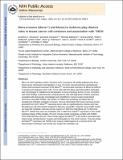| dc.contributor.author | Roussos, Evanthia T. | |
| dc.contributor.author | Goswami, Sumanta | |
| dc.contributor.author | Balsamo, Michele | |
| dc.contributor.author | Wang, Yarong | |
| dc.contributor.author | Stobezki, Robert | |
| dc.contributor.author | Adler, Esther | |
| dc.contributor.author | Robinson, Brian D. | |
| dc.contributor.author | Jones, Joan G. | |
| dc.contributor.author | Condeelis, John S. | |
| dc.contributor.author | Oktay, Maja H. | |
| dc.contributor.author | Gertler, Frank | |
| dc.date.accessioned | 2014-01-06T18:05:57Z | |
| dc.date.available | 2014-01-06T18:05:57Z | |
| dc.date.issued | 2011-04 | |
| dc.date.submitted | 2010-10 | |
| dc.identifier.issn | 0262-0898 | |
| dc.identifier.issn | 1573-7276 | |
| dc.identifier.uri | http://hdl.handle.net/1721.1/83503 | |
| dc.description.abstract | Mena, an actin regulatory protein, functions at the convergence of motility pathways that drive breast cancer cell invasion and migration in vivo. The tumor microenvironment spontaneously induces both increased expression of the Mena invasive (Mena[superscript INV]) and decreased expression of Mena11a isoforms in invasive and migratory tumor cells. Tumor cells with this Mena expression pattern participate with macrophages in migration and intravasation in mouse mammary tumors in vivo. Consistent with these findings, anatomical sites containing tumor cells with high levels of Mena expression associated with perivascular macrophages were identified in human invasive ductal breast carcinomas and called TMEM. The number of TMEM sites positively correlated with the development of distant metastasis in humans. Here we demonstrate that mouse mammary tumors generated from EGFP-Mena[superscript INV] expressing tumor cells are significantly less cohesive and have discontinuous cell–cell contacts compared to Mena11a xenografts. Using the mouse PyMT model we show that metastatic mammary tumors express 8.7 fold more total Mena and 7.5 fold more Mena[superscript INV] mRNA than early non-metastatic ones. Furthermore, Mena[superscript INV] expression in fine needle aspiration biopsy (FNA) samples of human invasive ductal carcinomas correlate with TMEM score while Mena11a does not. These results suggest that Mena[superscript INV] is the isoform associated with breast cancer cell discohesion, invasion and intravasation in mice and in humans. They also imply that Mena[superscript INV] expression and TMEM score measure related aspects of a common tumor cell dissemination mechanism and provide new insight into metastatic risk. | en_US |
| dc.description.sponsorship | Virginia and Daniel K. Ludwig Graduate Fellowship | en_US |
| dc.description.sponsorship | Massachusetts Institute of Technology. Ludwig Center for Molecular Oncology | en_US |
| dc.description.sponsorship | National Cancer Institute (U.S.). Integrative Cancer Biology Program (Grant U54 CA112967) | en_US |
| dc.language.iso | en_US | |
| dc.publisher | Springer-Verlag | en_US |
| dc.relation.isversionof | http://dx.doi.org/10.1007/s10585-011-9388-6 | en_US |
| dc.rights | Creative Commons Attribution-Noncommercial-Share Alike 3.0 | en_US |
| dc.rights.uri | http://creativecommons.org/licenses/by-nc-sa/3.0/ | en_US |
| dc.source | PMC | en_US |
| dc.title | Mena invasive (Mena[superscript INV]) and Mena11a isoforms play distinct roles in breast cancer cell cohesion and association with TMEM | en_US |
| dc.type | Article | en_US |
| dc.identifier.citation | Roussos, Evanthia T., Sumanta Goswami, Michele Balsamo, Yarong Wang, Robert Stobezki, Esther Adler, Brian D. Robinson, et al. “Mena invasive (MenaINV) and Mena11a isoforms play distinct roles in breast cancer cell cohesion and association with TMEM.” Clinical & Experimental Metastasis 28, no. 6 (August 12, 2011): 515-527. | en_US |
| dc.contributor.department | Massachusetts Institute of Technology. Department of Biology | en_US |
| dc.contributor.department | Koch Institute for Integrative Cancer Research at MIT | en_US |
| dc.contributor.mitauthor | Balsamo, Michele | en_US |
| dc.contributor.mitauthor | Gertler, Frank | en_US |
| dc.relation.journal | Clinical & Experimental Metastasis | en_US |
| dc.eprint.version | Author's final manuscript | en_US |
| dc.type.uri | http://purl.org/eprint/type/JournalArticle | en_US |
| eprint.status | http://purl.org/eprint/status/PeerReviewed | en_US |
| dspace.orderedauthors | Roussos, Evanthia T.; Goswami, Sumanta; Balsamo, Michele; Wang, Yarong; Stobezki, Robert; Adler, Esther; Robinson, Brian D.; Jones, Joan G.; Gertler, Frank B.; Condeelis, John S.; Oktay, Maja H. | en_US |
| dc.identifier.orcid | https://orcid.org/0000-0003-3214-4554 | |
| mit.license | OPEN_ACCESS_POLICY | en_US |
| mit.metadata.status | Complete | |
